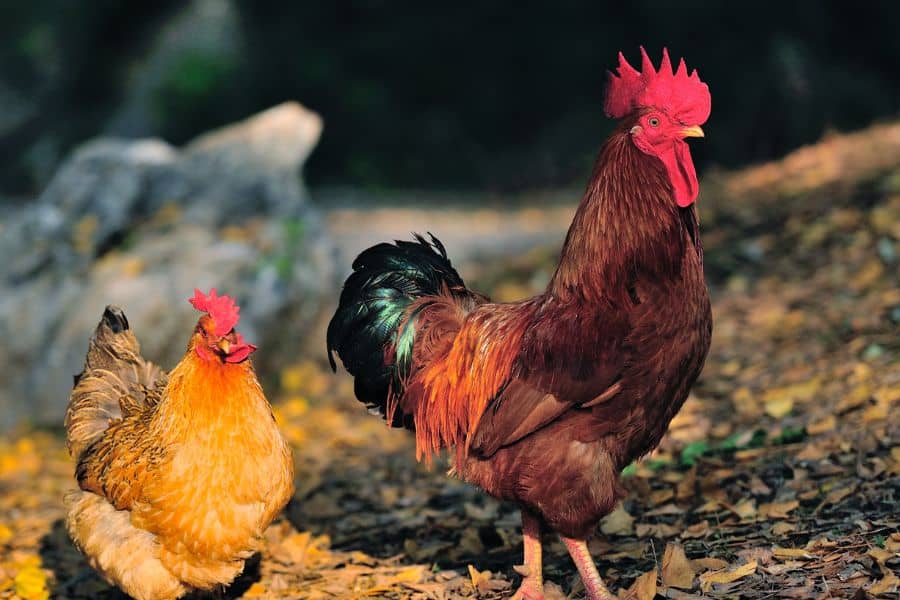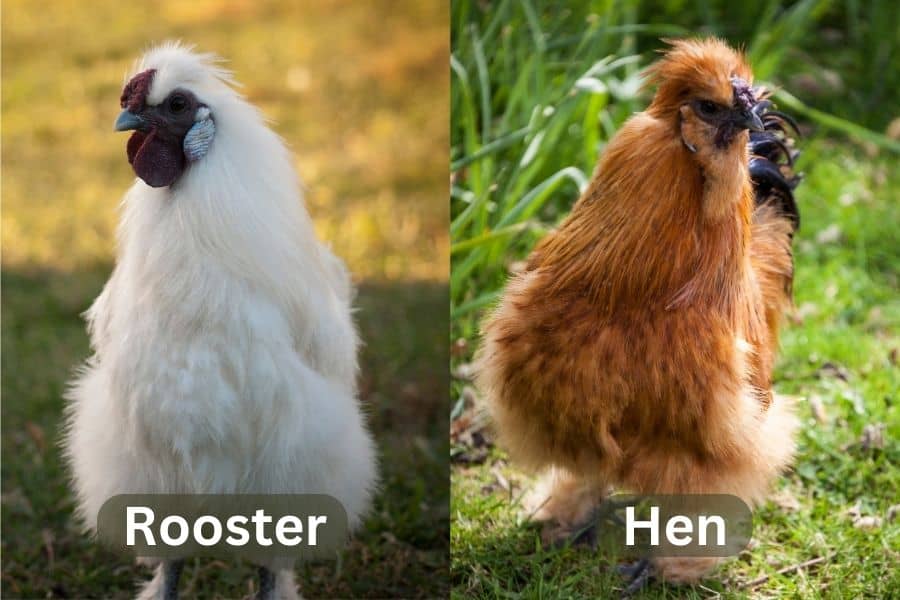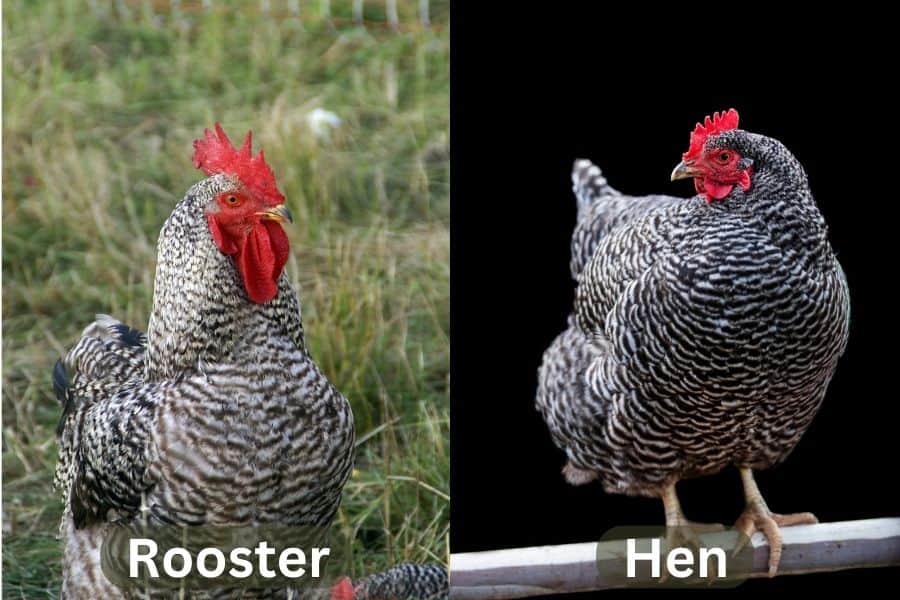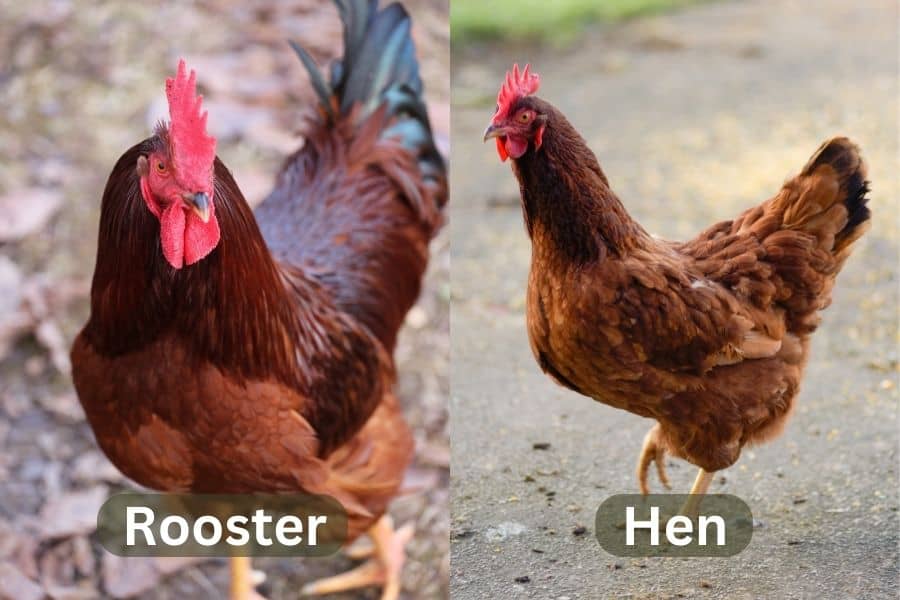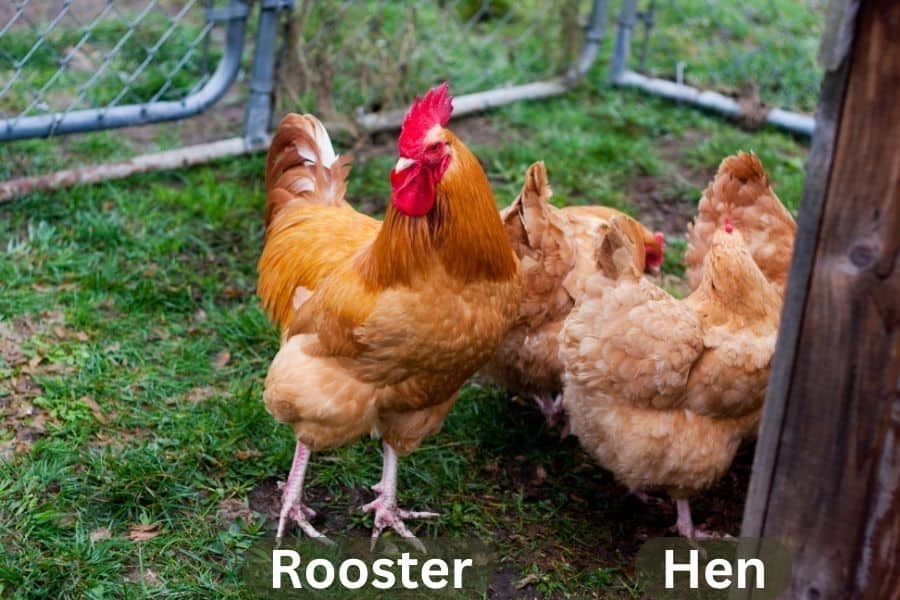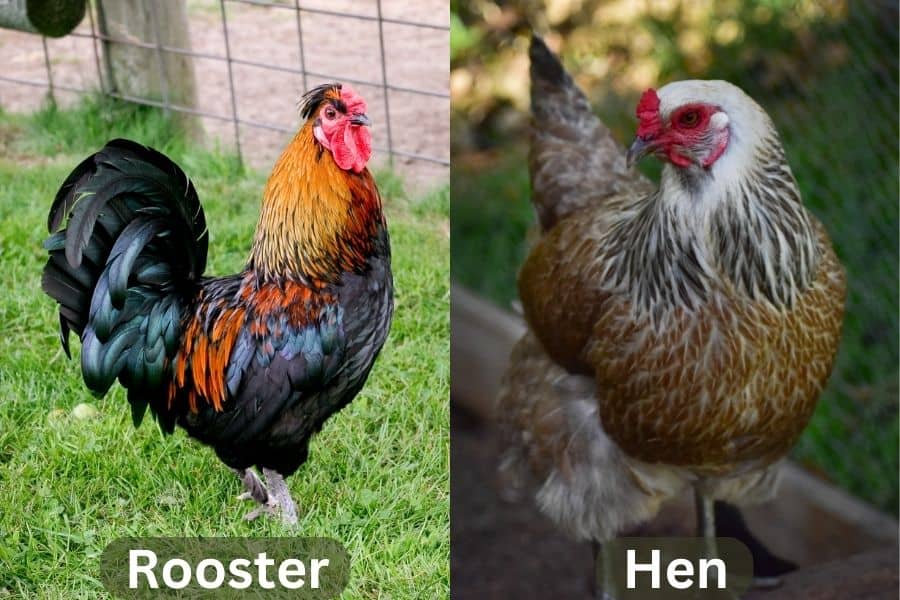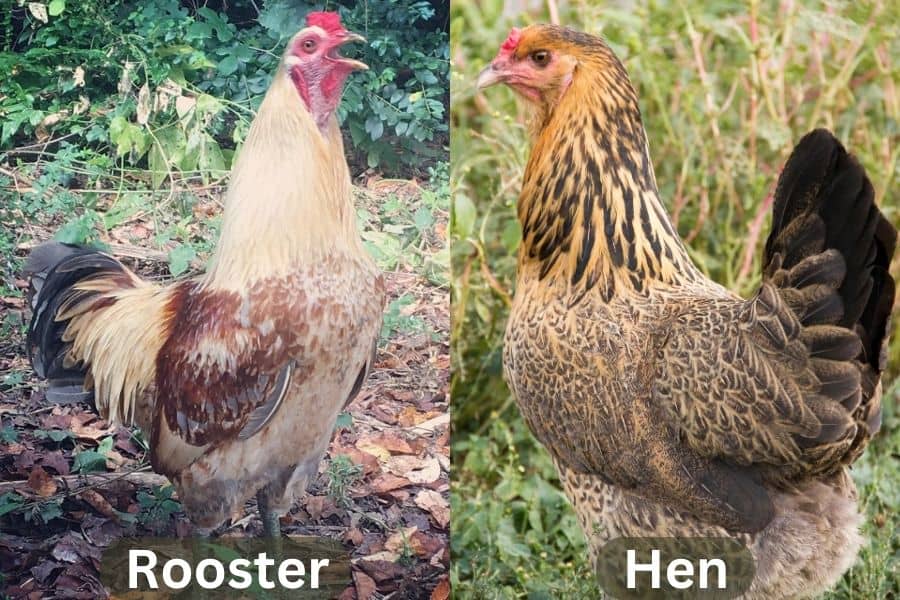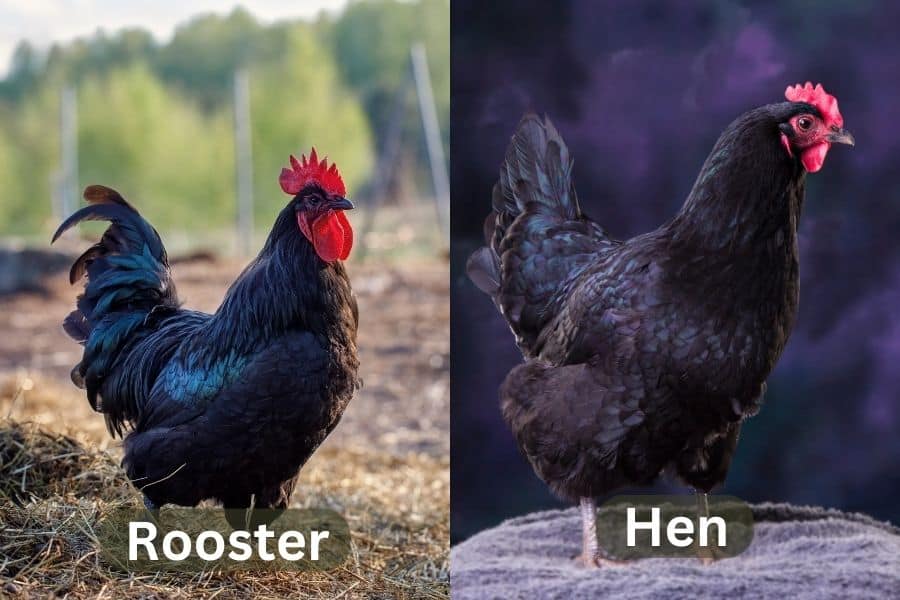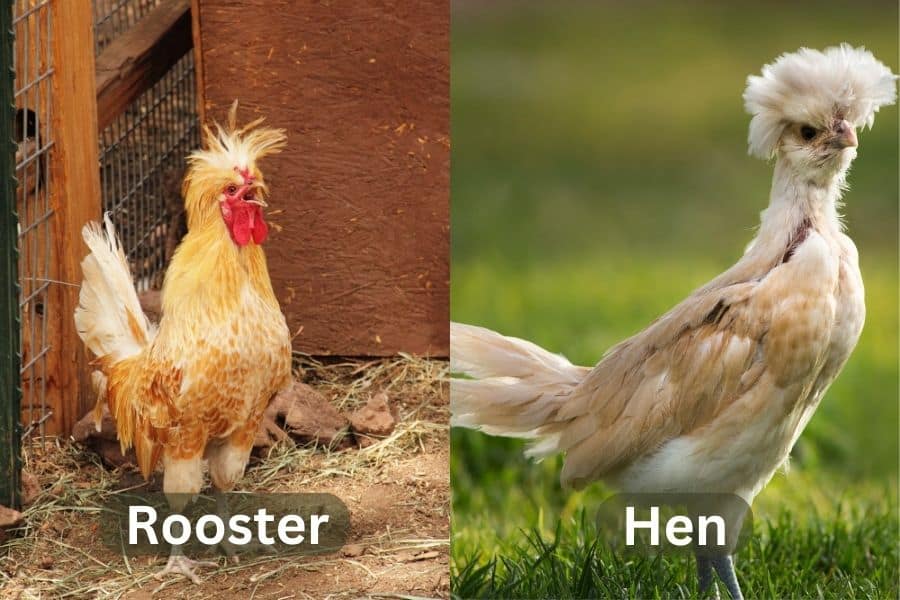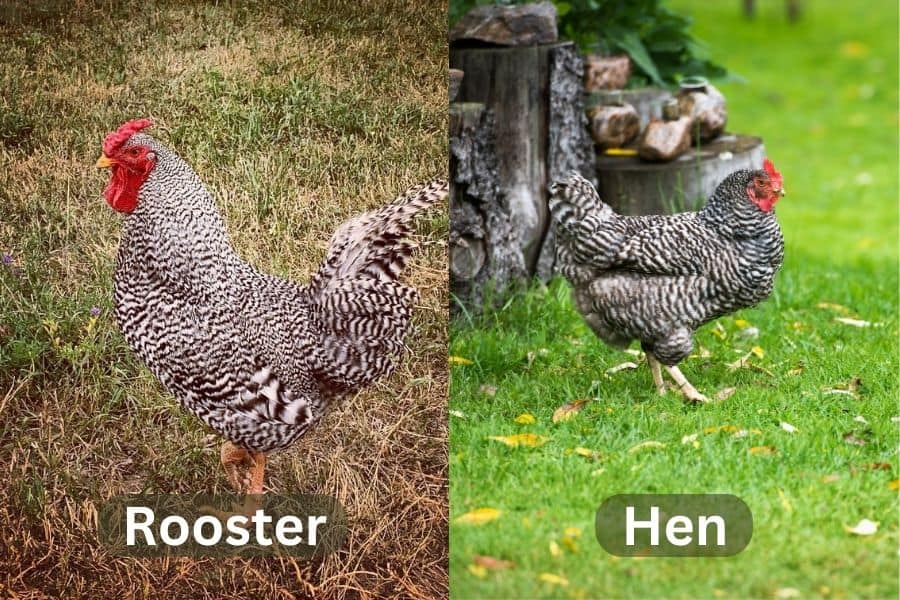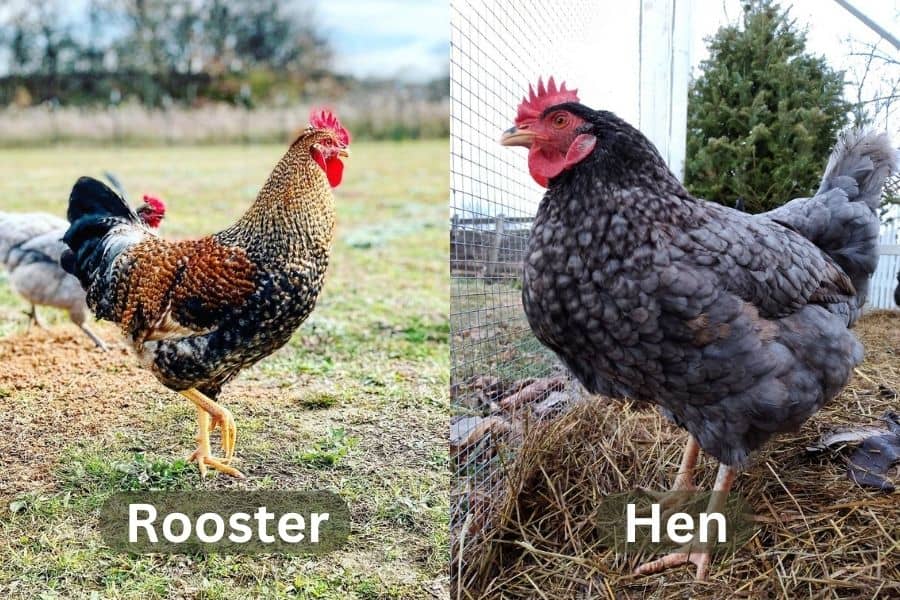Are you looking to control or manage breeding in your flock? Or do you want to know the differences between roosters and hens?
Either way, you’ve stopped at the right page.
Distinguishing male and female chickens can be tricky for both novice and experienced farmers. This rings true, especially if the birds are young.
But as they grow up, they exhibit distinctive traits that can help you know if you have only hens, roosters, or a mixture in your flock.
In this guide, we will cover the characteristics that differentiate roosters and hens when they are chicks and as they mature.
In addition, we will highlight defining features of male and female chickens of various breeds.
How To Differentiate Roosters and Hens
Physical Differences
You can tell between roosters and hens based on their appearance. A rooster’s body is usually covered with vibrant feathers than hens. But this can vary between chicken breeds.
Both roosters and hens have saddled feathers. These are the feathers that cover the back of the birds, as well as their neck and shoulders. But in male chickens, the feathers are long, prominent, and more colorful. As a result, they give roosters their unique visual appeal.
Additionally, the rooster boosts a single sickle feather (a long curved tail feather), which your girls don’t have. Some even develop small spurs on their shanks that they use for defense.
As far as physical traits go, roosters stand out more, thanks to their large combs and wattles. The coloring of these body parts, plus the earlobes and faces, will be more vibrant in your boys than in girls.
Behavior Differences
A chicken’s behavioral characteristics can also help you determine whether it’s a male or a female.
Behaviors common in roosters include:
- Crowning and Clucking
- Mounting hens
- Protective tendencies
- Occasional sparing
In hens, you might observe the following behaviors:
- Broodiness
- Egg laying
- Squatting for mating
But on some rare occasions, some hens might display male-related behaviors. This happens if the flock lacks a rooster.
How To Tell If a Chick Is Male or Female
As said earlier, it’s much easier to tell between roosters and hens when they’re fully mature. But when they’re just tiny balls of fluff, it’s another story.
We can both agree chicks often look the same once they hatch. But fortunately, there are a few techniques that poultry owners can use to sex their baby chickens. These include:
I. Vent Sexing
Vent sexing is done professionally at hatcheries. It is a highly sought method for those who want to purchase an all-female flock.
Unlike mammals, which have external sex organs, poultry sex organs are on the inside. That is why it’s challenging to sex your chicks just by ‘checking between their legs’.
Vent sexing is done by examining their cloaca (the vent area and sex parts) immediately after hatching.
In roosters, the cloaca lies above the base of the tail feathers and is covered by cloacal protuberance (a fleshy flap of skin).
While the hen’s cloaca is located above the tail feathers, it lacks the cloacal protuberance. Instead, it appears as an opening that serves as an exit for the lovely eggs we love, as well as waste materials.
Though not foolproof, this method is highly accurate. Occasionally, you might end up with a lone cockerel in your flock of females.
II. Autosexing
Autosexing method involves differentiating between male and female chicks based on coloration, patterns, and oddities on their down feathers.
However, this method works only for those chicken breeds with distinct colors for roosters and hens as baby chicks. This trait is unique to pure breeds, like Silver Leghorn, Cinnamon Queens, and Barred Plymouth Rock.
Depending on the chicken breed, a male could have a light or dark-colored spot on his head, whereas a female chick doesn’t. Or the girls could hatch out with a dorsal stripe pattern.
III. Observe Combs and Wattles
Another accurate way to tell between your female and male chicks is to check the size of the comb and wattle as they develop. Remember that a bright red comb usually signifies a healthy and sexually mature chicken.
For most breeds, the male chicks develop earlier. At about 6 to 8 weeks, a little rooster’s comb will appear and turn bright red.
With pullets, the comb and wattle will appear at about ten weeks and have a lighter shade than their male counterparts. However, they often become significantly enlarged and darker when they’re about to lay eggs.
Different breeds have different sizes of combs. You might find certain hens with large combs, sometimes even larger than their rooster peers.
Alternatively, there are certain breeds with very tiny combs (pea combs, rose combs, cushion combs), like Easter Eggers. Such combs might make it difficult to determine the sex of your chicks accurately.
IV. Feathers and Wings
YouTube Clip:
In the clip above, you can see that male chicks have wing feathers with alternating lengths. For females, their wing feathers appear to have a uniform length and almost align.
At about 8 to 10 weeks, these chicks will start growing pronounced hackle feathers (they grow at the base of the neck) and saddle feathers.
At this point, the rooster’s feathers will grow long and pointy, while a hen’s feathers will be shorter, more uniform, and rounded.
V. Look at the Legs
Physically, males are always larger than females. Even in the early stages of life, male chicks will grow larger and taller than female chicks.
A male chick’s legs will begin thickening quite earlier than the females. With some breeds, they might develop little spurs at the back of each leg.
VI. Behavioral Differences
If you compare males and females of the same age, you’ll find that males hold themselves higher than their female peers.
While females will appear more docile and subdued, males will be up and about, standing tall and practicing puffing out their chests. Sometimes, you’ll find them trying to assert dominance over each other.
You’ll also find that male chicks are friendlier and less averse to petting and handling, unlike females.
Similarly, males may start practicing tidbitting. This is where the rooster scratches the ground, dances, and makes high-pitched clucks to show off or share food with the females.
A rooster doesn’t crow ‘properly’ until it reaches about four or five months old. But that has never stopped them from trying. A male chick starts practicing its crow as early as eight weeks old.
Check out this beutiful video of a baby rooster crowing for the first time:
Spotting Difference Between Roosters and Hens Across Different Breeds
1. Silkies
Originally bred for companionship in China, Silkies are unique bantam (small-size) chicken breeds. Their exotic plumage and crests have earned them the name ‘Afro chickens.’
Unlike in other chicken breeds, it is easy to distinguish between the male and female Silkies. The most notable difference is the wattle. Silkie roosters will show a clear wattle as early as six weeks old. Whereas, a silkie hen will take about 6-9 months to grow wattles.
Additionally, male silkies grow longer crown feathers called streamers. The hen will retain the same length feathers that, with time, come to resemble a circular afro. Additionally, a male silkie’s comb is more U-shaped, while the female’s is V-shaped.
Roosters are also a little taller and larger than the hens. And by the age of six months, have developed spurs. They also have an erect posture with their chest puffed out and tails upright.
Did you know silkies can inherit the Frizzle gene? This gene creates sizzle chickens. Sizzle chickens possess curly feathers all over their bodies.
2. Barred Rock
Developed in the 1870s, the Barred Plymouth is a hybrid of several chicken breeds, including Dominiques, Black Javas, Black Cochins, Malays, and even Dorkings. It is also super popular among chicken owners across America.
The Barred Rock is an autosexing chicken breed. This means you can distinguish male and female chicks by their different down feather colors/patterns.
As adults, Barred Rocks all have distinct white and black bars all over their bodies. However, the roosters are a shade lighter than the hens. Thus, they appear more grey and white rather than black and white.
The Barred Rock rooster also sprouts a large upright bright red comb, while the hen’s comb is smaller with a subdued color.
The male chickens have long and short sickle feathers on their hind end. They also have longer, pointed hackle feathers, whereas the hens have shorter, softer, and rounded ones.
The rooster’s hackles come in at around 8 to 12 weeks, making it easier to distinguish them from the females.
3. Rhode Island Red
Originating from Rhode Island and Massachusetts, Rhode Island Reds are among the most renowned breeds in America and globally. They were bred in the 1800s as a dual-purpose breed. This breed is a top-tier egg layer and produces quality meat.
The rooster boasts a stocky block-shaped body, thicker and longer legs, large feet, a tall comb, and a large deep red wattle.
On the other hand, the hen has a smaller frame, shorter legs, and a short neck. Their comb and wattles also appear smaller with a pink shade. In addition, their feathers are shorter, denser, and more uniform.
The Rhode Island Red roosters are a sight to behold. They boast deep mahogany red plumage adorned with lustrous black feathers. We can’t forget to mention their long, majestic, black tail feathers with deep green highlights that shine under sunlight.
The hen’s plumage ranges from light rust to a dark reddish-brown color. Though it’s uncommon, you might find hens with short, green-black tail feathers. Their beaks are brownish as compared to the rooster’s deep red.
4. Buff Orpingtons
Buff Orpingtons are fascinating to look at. Sometimes, it gets quite hard to tell the difference since the Buff Orpington rooster looks quite similar to the hen.
Buff Orpington roosters have distinct features, but they are not very noticeable compared to other breeds. As such, we focus more on the subtle physical differences between the two.
First, let’s consider their size. Buff Orpington roosters are larger and more robust than the hens. They’re also louder and more vocal than the girls. More so, the roosters have prominently thicker legs and spurs on the ankles of each foot.
In terms of feathers, the roosters have a main sickle-shaped tail feather and highly arched saddle feathers. They also have larger combs and wattles with a darker shade of red.
5. Ameraucanas
This unique, highly sought out breed was developed to fix a few health problems that its predecessor, the Araucana chicken, struggled with.
Ameraucanas stand out from the crowd thanks to their blue eggs. But they are also stunning, and the roosters are often used as show birds.
Much like other chicken breeds, the Ameraucana rooster will grow a prominent red comb. Though small, it is much larger than the females. The wattles are also almost non-existent.
The most fascinating thing about this breed is its unique plumage. As mentioned above, the roosters are raised as show birds. That is because of the length and volume of their hackle feathers. Their feathers are longer, pointier, and larger than the females.
Despite having pea-size combs, the roosters make up for it with their longer hackle feathers. These grow quite compact and thick, giving them their unique, aesthetically pleasing visuals.
Physically, the hens are much smaller and subdued when compared to the roosters. The roosters also have a strut to their walk and are more active and aggressive.
6. Easter Eggers
The Easter Egger is not a heritage breed. However, it is a term used to refer to the crossbreeds of chickens that lay blue or green eggs. They also come in a variety of colors, making it difficult to determine their sex as chicks.
Since most Easter Eggers originate from the Ameraucana and Araucana breeds, they share the same physical characteristics with their parents.
The Easter Eggers are a medium-sized breed, but the roosters are usually bigger and taller than the hens. You can tell the difference in their size from as young as ten weeks old.
The cockerels start growing combs and wattles at about 6 to 10 weeks old, while the pullets might take up to 20 to 26 weeks. By the time they mature, the rooster’s wattle and comb will be larger, darker, and longer than the hens.
The roosters’ head and neck feathers tend to have different colors. Their feathers are also narrow, long, and pointy.
The hens have more uniform colors on their feathers. Their feathers are usually shorter and smaller than the roosters.
7. Australorps
The Black Australorp, famous for its all-black body and vivid red comb and wattle, is native to Australia.
Australorps are a favorite breed among backyard farmers. These large chickens are excellent egg layers, and their size makes them exceptional meat birds. They also have a gentle and friendly disposition, which allows them to co-exist with other chickens, even the aggressive ones.
Australorps hens and roosters share many physical traits. Because of this, most chicken owners might struggle to distinguish between them.
However, you’ll notice the male chickens have impressive tail feathers that radiate green, blue, or purple hues when light hits them.
The females have short, soft, rounded hackle feathers and lack saddle feathers. Likewise, the roosters grow narrow, pointy, and elongated hackle and saddle feathers.
Roosters also develop faster than hens – you can spot them once they grow their vibrant red comb and wattle. A hen’s pair will grow at a later age, and they will have a lighter shade.
8. Polish Chicken
Polish chickens are difficult to sex as chicks. This is because they look unnervingly similar, and you may have to wait until the most obvious physical traits manifest to differentiate them.
However, there is a loophole. You can sex polish chicks between 1 and 2 weeks old.
At this point, female chicks have a circular puff on their heads, while the males will be spotting a more rectangular, uneven puff. After two weeks, the chicks shed their fluff, and the window closes.
The plumage is a dead giveaway also when they are adults. While both sexes have topknots, the rooster’s topknot appears tousled, with an abundance of sharp-tipped streamer crest feathers.
The hen’s topknot is much more circular, sleeker, and compact. It also starts resembling a bob. Hens don’t grow any streamers.
The rooster’s tail is long, bushy, and voluminous, while the hen’s is more tamer and shorter. Polish chickens don’t grow the biggest wattles.
Most times, the females don’t even have wattles. And if they do, they’re small, pink, and often hidden beneath the feathers.
9. Dominique Chicken
Also known as the Pilgrim Fowl, the Dominique chicken is one of the oldest recognized chicken breeds in America. In colonial times, people raised this breed for its eggs, meat, and feathers.
Dominiques are an autosexing breed. The females have a small, concentrated white dot above thier heads, while the males have a large, more widespread white patch.
Sometimes, you can tell the difference by their leg color. Male chicks tend to have dark yellow legs, while the females’ legs look orange bordering brown.
As adults, the rooster’s feathers are a lighter shade when compared to the hens. Not to mention the large rose comb and wattles that turns bright red upon maturity.
The roosters have wide bodies, thicker legs, long upturned tail feathers, and large wings. Conversely, hens have a slender frame with shorter, rounder feathers.
10. Olive Eggers
The Olive Egger is a cross between a male, brown-laying chicken and a female blue-laying chicken breed. The result is a friendly, docile Olive Egger that can lay eggs with rare shades of olive-gree and blue.
This hybrid is an autosexing breed. Thus, as chicks, males will have a large white dot on the head, while females won’t. Also, the female wingtips will have alternating long and short pin feathers, while the male will have uniform feathers.
It’s hard to tell the difference physically since the chickens will carry some traits from their parent breeds. But if you’re determined to get a specific color or traits, you can find the right parents to crossbreed.
For example, crossing an Ameraucana and a black Marans might get you Black chickens with Ameraucana beards and muffs.
As adults, the roosters will be larger and heavier than the females. The rooster will grow a red wattle and comb as early as 6 to 8 weeks old.
The hackles and saddle feathers will come in at 10-12 weeks of age. They will be elongated and pointy. For the females, the feathers will be soft, short, rounded, and uniform.
Read More: How Many Hens Per Rooster?
Closing Thoughts
Most chicken farmers only know when they have boys or girls in their flocks when the birds’ crow or lay eggs. That’s because it is hard to know whether you have male or female chickens when they are still young.
The good news, chicks often develop subtle physical and behavioral differences you can use to identify roosters and hens.
However, some breeds are not easy to sex. In fact, you might need to raise them for a long time before you can successfully differentiate the chicks. But you can save yourself this hassle by investing in auto-sexing breeds like Barred Rock.
On that note, we hope this information will help you with your flock management efforts!
